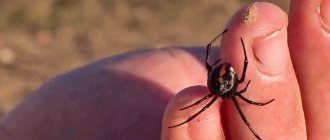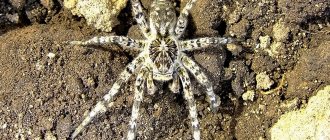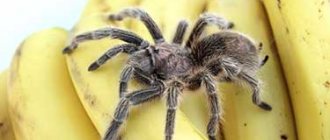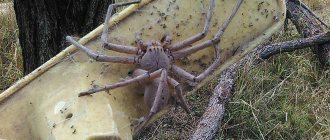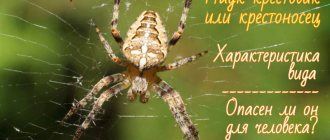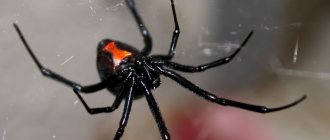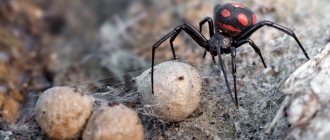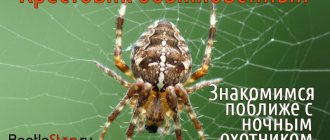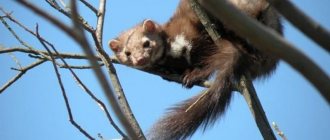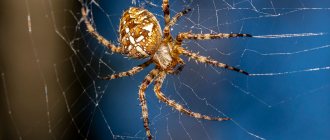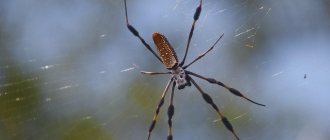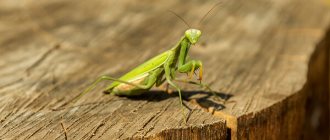When hearing the words: tarantula spider, a resident of the English-speaking space usually imagines a huge tarantula. Inhabitants of the southern regions of the former USSR immediately remember large gray spiders of the genus Lycosa, digging holes in the dry steppes of Southern Ukraine, Crimea and the Krasnodar Territory. Now the same associations will arise among citizens of Belarus and residents of the more northern regions of the Russian Federation. Due to global warming or other reasons, the population of the South Russian tarantula in Russia has significantly expanded its habitat.
Report No. 2
A tarantula is a spider that uses its web only to arrange the walls in its burrow where in the future it will begin hunting or its female will lay eggs, which is considered dangerous for people, but in fact represents a real danger only for animals.
Where does the tarantula live?
The tarantula lives and builds burrows for caring for offspring and hunting, in dry ones without a single hint of moisture; when it finds this place, it begins to build a burrow about 60 centimeters deep, the walls of which are then reinforced with its cobwebs. At night, the spider leaves its burrow into the desert or steppe and begins to hunt.
What does a spider eat?
The spider most often begins its hunt at night; it either sits in a burrow waiting for prey or moves freely around the area. Now the prey is already nearby, the tarantula attacks and injects poison into the body, thereby either paralyzing or killing the prey. Most often, the tarantula feeds on not too large insects, such as mole crickets, ground beetles, crickets, cockroaches, beetles, caterpillars and others.
Types of tarantulas.
In total, about 221 species of tarantulas are known, for example:
- Spanish tarantula
- Brazilian tarantula
These are just a few, they differ only slightly in appearance, but are approximately similar in characteristics, but the most popular species are considered to be the South Russian tarantula and the Apulian tarantula, which reaches approximately 6 - 7 centimeters in length.
Reproduction.
Towards the end of summer, the female tarantula tries to find a suitable hole, when she finds it, she lays eggs and wraps them in a web, which she carries with her, after the young tarantulas hatch, some of them remain in the female tarantula’s abdomen.
Bite.
In general, a tarantula’s bite is dangerous only for animals; humans are not in danger of anything fatal, and its bite in terms of pain can be compared to a hornet’s sting and at most can cause swelling, but nothing more. And the antidote to his poisonous saliva is contained in his hemolymph.
History of the name.
Where did this name come from? Once upon a time in the city of Toronto it was generally accepted that the bite of such a spider led to illness, a strange disease, Tarantism, and as people believed there was only one way to recover from a terrible, deadly disease - this was to perform a ritual by dancing the unusual dance Tarantella, but as it turned out later, everything These rituals took place not because of a fatal disease, which turned out to be false, but only in order to hold a feast, which the government did not approve of at that time, but after all this the name of the spider never changed.
2, 3, 4, 7 grade
Why is the Crimean tarantula dangerous?
Even people who are calm about spiders in general are often afraid of tarantulas - because of the size and rumors about the “mortal danger” of this particular arthropod. For such people there is two news, bad and good. First: the tarantula is poisonous. Second: its bite is not dangerous to human life.
Of course, if there are specific reactions, tragedy can occur. But in general, the dose of poison in a tarantula is not sufficient to kill a large animal (which includes humans). It can easily kill a mouse or even a very large insect, but the dimensions of a person are hundreds of times larger!
But still, a tarantula bite is quite common, especially considering that these spiders often climb into tourists’ tents and inhabit old private houses. They do not perceive humans as prey (for obvious reasons), but they often attack if for some reason they decide that they are in danger.
Due to its size, the spider easily bites through human skin (it bites, not stings, that is, it uses its mouth parts for this), and the venom can provide the victim with several unpleasant hours. Enlarged lymph nodes, fever, dizziness, difficulty breathing, nausea - this is a completely common set of consequences of an unsuccessful encounter with a tarantula.
More interesting: Snakes of Crimea
Natural enemies of tarantula spiders
Photo: Black tarantula spider
The tarantula has quite a few enemies. The main culprits in the death of arthropods are birds, since they are part of the diet of birds. Wasps encroach on the life of arachnids, just as spiders do with their victims. They inject poison into the tarantula's body, paralyzing the predator.
They then lay eggs inside the spider. Parasites live and develop, after which they get out. Natural enemies include some types of ants and mantises, which are not at all picky about food and eat everything that moves. Frogs and lizards are not averse to eating tarantulas.
The most dangerous enemy is still the same spider. Arthropods tend to eat each other. A female, during the process of fertilization, can encroach on the life of a male individual, like a female praying mantis, or eat her offspring if she cannot trap some insect.
There is continuous hostility between tarantulas and mole crickets. Their habitats overlap. Mole crickets dig the soil, where spiders often climb. Sometimes individuals manage to escape. Wounded or molting arthropods usually become food for the enemy.
In general, the population suffers most in early spring. When lethargic and sleepy arachnids crawl out of their shelters, the mole cricket is right there. Sometimes they climb into spider holes and attack tarantulas with their forelimbs, delivering heavy blows. When the spider loses a lot of blood, the mole cricket eats it.
Is it possible to reproduce
Sexual maturity in females occurs 1.5-2 years later than in males. If for males this is 1.5-2 years, then for females it is 4-5 years. The mating period begins at the end of summer. After mating, the male usually dies, and the female begins to prepare for the winter. Female tarantulas lay eggs and place them in a silk cocoon, which is attached to the outside of the abdomen. “Gestation” lasts 40-50 days. During this period, under natural conditions, the female tries to be in the sun more often in order to speed up the incubation process, but at home it is worth increasing the temperature in the terrarium to +30...+32 °C.
A clutch can contain from 50 to 500 eggs. After the incubation period is completed, the little spiderlings remain with their mother for another month, sometimes covering her entire body. After the expiration of a month, the babies leave the female and begin to lead an adult lifestyle. There are cases when the female herself drives away the young or even eats some part of it, so the babies need to be weaned on time.
Well, now you have the necessary knowledge on how to properly keep a tarantula at home, let this knowledge be useful to you, and remember: we are responsible for those we have tamed.
Among the wolf spiders there are interesting, surprising representatives. For some, their appearance is terrifying, while for others, on the contrary, they seem incredibly beautiful. Large araneomorphic venomous spiders called tarantulas
They are an incredibly beautiful furry creature, which in the old days was considered poisonous and dangerous to humans.
Tarantula tarantula
A lot has changed since then. It has been proven that tarantulas are not too dangerous for humanity, but this does not stop some people from looking at them with caution. Just the sight of it makes you shiver involuntarily, even in the photo of a tarantula.
Tarantula bite
although not fatal, it can cause some trouble. After it, the victim may experience a feverish state.
Sometimes, judging by numerous literary descriptions, the aggressive behavior of these spiders was noticed. But this does not mean that such behavior is characteristic of all their representatives.
Tarantula bite
In fact, they live more according to the law - “don’t touch me, and I won’t touch you.” And to a greater extent they can bite only for the purpose of self-defense. By the way, according to eyewitnesses, the bite of these spiders resembles a wasp bite. They do not produce such a large amount of toxins that could negatively affect the health of a person who has been bitten.
Social structure and reproduction
Photo: Poisonous tarantula spider
The period of sexual activity occurs in the last month of summer. The male weaves a web, after which he begins to rub his belly against it. This provokes ejaculation of seminal fluid, which flows onto the web. The male plunges his pedipalps into it, which absorb sperm and become ready for fertilization.
Next comes the stage of searching for a female. Having found a suitable candidate, the male emits vibrations with his abdomen and performs ritual dances, which attracts females. They lure out hiding females by tapping their paws on the ground. If the partner reciprocates, the spider inserts its pedipalps into her cloaca and fertilization occurs.
Then the male quickly retreats so as not to become food for his chosen one. The female weaves a cocoon in the hole in which she lays eggs. Their number can reach 50-2000 pieces at a time. The female carries the offspring on herself for another 40-50 days. The hatched babies move from the mother's abdomen to the back and remain there until they are able to hunt on their own.
The spiderlings grow quickly and soon begin to taste the prey caught by their mother. After the first moult they scatter. By 2-3 years, predators become sexually mature. During this period, arthropods lose their instinct of self-preservation and are easy to meet in broad daylight.
Clean
South Russian tarantulas are hunters. Their food is everything that runs along the surface of the soil, but does not greatly exceed the size of the spider itself: beetles, flies, mosquitoes, midges, caterpillars, worms, ground beetles. But the tarantulas themselves are lucky, few people like to feast on them. Except for wasps and birds.
Mizgiri, like all arachnids, have extraintestinal digestion. They attack the victim, once within jumping distance, and approach silently and unnoticed. The poison is deftly injected along with the contents of the midgut, immobilizing the prey. Then the spider sucks the liquid from the victim’s body, like a cocktail from a straw. And what he doesn’t finish, he throws away away from himself. Sort of a neat guy.
Another feature of the South Russian tarantula is that it does not weave a web for hunting. It is needed only to protect the home - it seals the entrance from unwanted guests. The spider lives in a hole up to 50 cm deep. It spends time in it during the day, and from it it tracks down unwary living creatures. Mizgir rarely goes far from the hole, he does not like to be active much and is poorly oriented in space.
Home content
If you decide to keep a South Russian tarantula at home, then remember that it is quite fast and does not tolerate mistakes in handling. When trying to defend itself, it can jump to a height of about 15 cm and will certainly bite.
As for the content itself, the South Russian tarantula is unpretentious. He needs:
- a vertical terrarium from which the spider cannot escape on its own;
- a fairly thick layer of substrate - at least 30 cm, so that your pet can dig its holes in it;
- a drinking bowl that will contain clean and fresh water every day, and the spider should have free access to it;
- food – for the South Russian tarantula I usually buy food insects, the body size of which should correspond to the body size of the spider itself.
Important! Feeding the South Russian tarantula with insects from the street is highly not recommended!
Varieties
In total, more than 200 varieties of arthropods of this species can be found in nature. We will look at the most common types of tarantulas, where they are found, and what appearance is typical for them.
- Apulian. Its size is about 7 cm, males have a uniform color, while in females it is more varied and combined. The cephalothorax is combined, there is a light stripe, the abdomen is red in color, on which there are several stripes with a white-red border. They live in the mountains, where they create burrows up to 60 cm, and the entrance is always lined with leaves. This species of arthropod does not spin webs. During the day they sit inside the hole, where at night they can get food, or they leave the hole to hunt. Before cold weather, they seal the entrance to the house with dry grass and hibernate. After the onset of puberty, subject to natural habitat, females live no more than 5 years, males - a maximum of 3 years. The question of where they are widespread is difficult to answer. As a rule, these are Egypt, Italy, Libya, etc.
- Mizgir. Where it lives - in fields, gardens. Found in Russia and Ukraine. Dimensions – up to 35 cm, females are larger than males. The color depends on the color of the soil where the spider lives, so you can find dark brown, brown, or red specimens. There is a dark spot on the head. They dig themselves small holes up to 50 cm, where they line the holes with a special wall made of soil, grass, and plants. When molting begins, the spider closes the entrance to the hole with cobwebs or soil, the same thing happens in winter, when cold weather sets in. To catch prey, these spiders do not weave webs, but hunt small insects and climb into holes, where they guard their prey. Life expectancy is up to 5 years.
- Lycosa narbonensis. Quite large, their size can reach 6 cm. The color is black, the paws are long and covered with hairs. Where they live - most often it is Malta, Italy, Spain.
- Spanish tarantula. They feed on small invertebrates; spiders tend to feed on representatives of their own species. Where they live: in Europe and northern Africa.
- Brazilian tarantula. It has 8 eyes, the size excluding paws is up to 3 cm. They have a brown color, a stripe on the head, which smoothly turns into a light yellow color at the top of the back. Where the abdomen is located, the stripe turns into an arrow pointing forward. The abdomen is black. Paws are brown-red. They feed on cockroaches, crickets and small spiders. Where they live: in America, Argentina.
- Lycosa poliostoma. Common in meadows and gardens. During the day they hide in the steppes, in the meadows they create holes for themselves. They hunt at night. They feed on spiders and small insects. If you do not take into account the legs, the length of the arthropod is 3 cm. They are brown in color. There is a stripe on the head, the shade of which is lighter than the main color. They differ from the Brazilian tarantula in that their color is lighter, but there is also a stripe on the abdomen that smoothly turns into an arrow shape. The lower abdomen is black. A characteristic feature of representatives of this species is that females have shorter legs than males, but they are also larger, as is common in tarantulas. Where they live: America, Brazil.
- Lycosa leuckarti. Their color is gray-brown. The maximum length excluding the legs in females is about 1.2 cm, males are smaller - 0.9 cm. Where they live: Australia.
- Lycosa coelestis. On average, the length of individuals is 13 mm. They are brown in color, with 2 dark stripes on the back, which are located longitudinally. The abdomen is painted black. Where they live: in Japan
Description of varieties
The description can begin with the lifestyle of tarantulas. In natural conditions, they are nocturnal. During the day, tarantulas rarely come to the surface of the earth; at this time they rest in their homes, which they build themselves. Their home is long vertical burrows; they can reach a depth of more than 70 cm. At night, the arthropod leaves the home and goes hunting.
There are approximately 220 species of tarantulas in nature. This number also includes extinct species. The most popular and studied tarantulas:
- Apulian;
- South Russian;
- Spanish;
- orange.
Apulian tarantula
It is sometimes called a true tarantula. Egypt, Sudan, Libya, and Spain are considered its homeland. The favorite habitats in nature for this arthropod are various mountain slopes. The appearance of these creatures varies depending on gender.
The female has a complex combined coloration: the head and chest are in dark colors, which end in a light line, the color of the abdomen is red with a pattern consisting of several stripes placed transversely, the stripes have a white-red border.
The male does not look so impressive. Its body has a more uniform color. The spider's body is covered with thick hairs. The sizes of tarantulas vary depending on gender. Females are larger and their length reaches 28 mm, males are much smaller, they grow up to 19 mm. The spider has 8 eyes: 2 pairs of main eyes and 2 pairs of side ones.
The main pair is dark brown, the side eyes have a bright shine. This is explained by the fact that their inner shell serves as a light reflector. The presence of such a number of eyes provides tarantulas with a wide angle of vision, helping them in searching for prey.
Tarantulas go hunting only at night, but if luck smiles on him and his prey approaches his hole, he will not miss the opportunity to feast on it. When the tarantula manages to catch an insect, it immediately grabs onto it with its chelicerae and releases poison. If the prey is large, he rotates it so that the poison gets to all sides of the insect. The Apulian tarantula feeds on beetles and other insects.
The process of procreation in tarantulas begins at the end of summer. After mating, the female lays eggs in a hole and makes a cocoon for them from a spider's web. She then attaches it to herself and wears it while waiting for the cubs to appear. After birth, the spiders live on the mother’s body for some time and move with her. Later they spread out and begin an independent life. The litter of one female is 300 individuals.
South Russian tarantula
The second name of the species is Mizgir. The South Russian spider lives in various gardens, fields, and deserts, which are located in the territories of Russia and the countries of Central Asia. Adult spiders are small in size, which differs somewhat between females and males.
The female grows up to 40 mm. Males do not exceed 25 mm. The color of the tarantula can change, it depends on the conditions of its habitat, namely the color of the soil on which it lives. There are black, brown, brown and reddish spiders. The main color is usually diluted with spots, which can have a variety of shapes and sizes.
A characteristic feature of this species is the presence of a large dark spot that adorns the spider’s head. Its home is a vertical burrow up to 50 cm deep, the entrance to which is protected by a layer of soil and plants. If it rains outside or the spider begins to shed, the protection of the house is strengthened with earth and cobwebs.
Mizgiri hunt without using webs. They simply wait for prey to appear within the radius they need. The average lifespan of a tarantula is approximately 5 years, with females living longer than males.
Spanish
Only since 2013 has this spider taken its place in arachnology as a separate species. Before this, it was considered a subspecies of the Apulian tarantula. He lives in Africa and southern Europe.
The Spanish tarantula uses the smallest invertebrates as food. These predators also eat their relatives. So in the relatives of this tarantula, cannibalism is common.
Orange
Known as the Brazilian red tarantula. This arachnid is distinguished by its large dimensions. It can grow up to 170 mm. Its body is dark brown in color and its surface is covered with hair.
The tarantula's diet includes insects, crickets and newborn mice. When excited, a tarantula can become aggressive. Therefore, people who have not encountered spiders at home should choose a more friendly arachnite.
Description and features of the tarantula
The main feature is a large number of eyes, 8 of them, due to which the spiders have a viewing angle of 360 degrees. They also have an excellent sense of smell, thanks to which arthropods can easily sense prey at a great distance. Its body is covered with small hairs, and in the structure itself two main parts can be distinguished - the head, which grows into the chest and protrudes as one whole, and the abdomen.
During its life, the tarantula spider changes the chitin found on the surface of its body. The arachnid has 4 pairs of long legs, which are covered with hair, which allows them to move freely through water or sand.
There are poisonous channels on the mandibles - they are used as a means of defense and attack and are very strong.
They are painted either black or brown, although you can meet animals of light shades - it all depends on where the animal lives.
Virulence
As a rule, they do not attack a person on their own, only if he forces him to do so on his own - for example, by hitting a mink or arthropod. An animal bite is not fatal to a healthy person; it is dangerous if there is an allergic reaction to the components of the poisonous substance.
The following unpleasant symptoms may occur:
- swelling, redness of the epidermis;
- malaise, drowsiness;
- hyperthermia;
- breathing problems;
- feeling nauseous or vomiting.
There are no non-venomous tarantulas. But the bite will be fatal only for the animal that the tarantula decided to hunt.
If a person is bitten by a tarantula, he still needs to receive help to avoid poisoning and subsequent intoxication. The following actions are performed:
- wash the bite site, preferably with an antiseptic;
- seek qualified medical help;
- Place a container of ice on the wound to cool the skin;
- if there are allergic reactions, take antihistamines;
- drink a lot of clean water - it removes toxins that poison the body.
External structure
Let's take a closer look at what tarantulas look like. It has 8 eyes on the top of its head - this is the case for almost every animal from this family, 4 of them are trapezoidal. It is difficult to say exactly what size a tarantula is, there are large specimens - up to 10 cm, and there are also very small ones, so it would be incorrect to say that all arthropods are large. Females are always larger than males - sometimes several times.
Chelicerae are stinging and at the same time oral appendages. Males are smaller than females and their limbs are not as developed. As for how many legs a tarantula has, the answer is the same: 4 pairs, that is, 8 in total, like the eyes.
Tarantulas are solitary and meet with other individuals when they need to reproduce, as a rule, this happens in the second half of August. Males always fight with each other.
Internal structure
Let's look at the structure of the tarantula. The following important systems can be distinguished:
- digestive. The liver is used as a gland that digests food; spiders have 2 stomachs, and there is also an intestine.
- Blood It looks like a tube from which a large number of vessels extend; a colorless liquid flows through them, which experts call hemolymph.
- Respiratory. The exoskeleton of an arthropod has openings called spiracles. Through them, air penetrates into the lungs, which also have an interesting structure. Each wall is folded like the pages of a book, which is why the lungs are usually called pulmonary books.
Even though arachnids do not spin webs, they still have arachnoid glands. Females weave cocoons for eggs from silk, which also serves to insulate and strengthen the mink.
Spider Lifestyle
The South Russian tarantula is a hunter sitting in ambush, which becomes a hole dug 50-60 cm deep. The spider learns about what is happening above by the vibrations of the web: with it it prudently entwines the walls of its shelter.
The signal to jump is also the shadow of an insect blocking the light. The tarantula is not a supporter of walks and takes them out of necessity, leaving the hole in search of prey after dark. When hunting at night, he is extremely careful and does not go far from his burrow.
It approaches the victim slowly, with stops. Then suddenly he jumps and bites. In anticipation of the killing effect of the toxin, it can relentlessly follow the insect, biting it and jumping away until the sufferer breathes his last breath.
The objects of attack of our tarantula are:
- caterpillars;
- crickets and beetles;
- cockroaches;
- mole crickets;
- ground beetles;
- spiders of other species;
- flies and other insects;
- small frogs.
Male tarantulas fight with each other, regardless of the seasons, and rest from civil strife only during hibernation.
Nutrition
Tarantulas are predators that feed mainly on insects, which is similar to all other spiders. The diet of these arthropods consists of:
- cockroaches;
- caterpillars;
- crickets;
- mole cricket;
- Zhukov;
- ground beetles;
- small amphibians (frogs).
Unlike most other spiders, tarantulas are active hunters. They rarely catch prey using webs, preferring to do it themselves. Most often, the spider lies in wait for an insect while in a shelter, and then grabs it and plunges its sharp jaws into it. If the prey tries to escape, the spider chases it, periodically biting it.
Having caught the prey, the predator injects it with poison, which has a paralyzing effect, as well as digestive juice. After some time, the insides of the victim turn into a nutritious liquid mass, which the spider sucks out. Adult tarantulas do not require daily feeding. They can easily go without food for days or even weeks.
Danger
All types of tarantulas are poisonous. The poison lies in the glands located in the cephalothorax and opening at the top of the tentacles-mandibles, with which the spider pierces the skin of its prey in order to then suck it out. Tarantulas do not attack humans on their own, but if they are teased, especially females wearing an egg cocoon or having young spiders on them, jump up and can bite a person.
For humans, a tarantula bite is never fatal, but causes swelling and pain in the bitten area. In addition, sometimes the skin turns yellow and remains that way for quite a long time (up to 2 months). There is no reliable information about the fatal outcome for humans from a tarantula bite.
The meaning of the tarantula in nature and human life
Although a tarantula bite can be dangerous to humans, these animals are actually beneficial to the environment where they eat pests.
It is noteworthy that sometimes tarantula venom is even used in the medical field, which is why they began to be bred in captivity. People have been trying for a long time to find out what the web is made of - in order to make fabric from it in the future.
There is a known case where one magician managed to create stockings and gloves from a spider’s web - but in one copy.
Types of Tarantula Spiders
The genus has more than 200 species. Recently, many exotic lovers have been dreaming of owning a blue tarantula spider, which was found in the forests of Guyana several years ago. Although in fact this is a hoax, because it belongs to the genus of tarantulas, which only inexperienced arachnologists can confuse with a tarantula. Among all the types, the most famous are the following:
- Lycosa tarantula
. The tarantula spider grows up to 7 cm. Females have a combined color: a dark cephalothorax and a red abdomen. The male is monochromatic. - Lycosa singoriensis
. Body size up to 3.5 cm. Color light brown, black-brown or reddish. There is a dark “cap” on the head. - Lycosa narbonensis
. Body size 6 cm. Color brown-black. - Lycosa hispanica
. Until recently, these tarantula spiders were considered a subspecies of the Apulian. The body of females grows up to 7 cm. - Lycosa erythrognatha
. It has eight eyes arranged in three rows. Body size 3 cm. Color dark brown, light longitudinal stripe on the head. - Lycosa poliostoma
. The body is small, 3 cm. The color is gray-brown or dark brown. - Lycosa leuckarti
. Size up to 1.2 cm. Color gray-brown. - Lycosa coelestis
. Body size 1.3 cm. Color brown with two stripes on the back.
Lifestyle
The South Russian tarantula spider does not weave a classic trapping web. He needs a web to build a hole (30-80 cm deep, 3-5 cm in diameter). The spider tries to arrange its home in an open, sunny area.
He needs the heat to warm his eggs and also helps him get food. Future victims, escaping the heat, huddle inside the predator's hole. Externally, it is a small round mound on the soil surface with a hole in the middle or on the side.
Mizgir digs the ground with chelicerae - jaws (oral appendages). If the soil is dense, the spider pre-soaks it with saliva. The separated lump is packed with cobwebs and thrown out.
In order to preserve its shape, the spider also braids a pile of earth dug out of a hole with a net. The process occurs only early in the morning or at night. It takes 1-2 nights for the tarantula to fully equip its hole.
Some mizgiri do not build an earthen embankment, but throw the soil to the sides. Such a dwelling can be recognized by a recess lined with sticks and grass - above its hole the spider arranges something like a small log house.
There are varieties that build a web dome over the entrance to the burrow . The spider sits under it during rain and during periods of molting. If the grass around is high, then above the hole you can see a vertical tunnel made of cobwebs, rising 10-20 cm.
Tarantula bite
The tarantula is quite gentle and does not attack a person without a good reason, including deliberate provocation or accidental contact.
A disturbed spider will announce the start of an attack with a threatening pose: it will stand up on its hind legs, raising its front legs up. When you see this picture, be prepared for an attack and a bite similar to a bee or hornet sting.
The toxin of the South Russian tarantula is not fatal, but a shallow bite is accompanied by severe pain, swelling, and, less often, nausea and dizziness.
The bite site is burned with a cigarette or match so that the toxin decomposes. Taking antihistamines will not hurt.
Tarantulas, including South Russian ones, are often kept at home: they are funny and unassuming creatures
You just have to remember that these spiders have a good reaction and a painful bite, so when handling them you need attention and composure
Based on observations, the South Russian tarantula, defending its lair, jumps up 10-15 centimeters. According to the general conditions of keeping, tarantulas differ little from the burrowing varieties of tarantulas.
An immutable rule that a newly-made tarantula owner must follow is that a single spider is housed in one terrarium. Otherwise, the residents will constantly find out which of them is stronger. Sooner or later, one of the fighters will be carried away from the battlefield lifeless.
It has been noted that in the natural environment the tarantula lives for two years, but in captivity it can live twice as long.
Arachnarius
Instead, a terrarium or an aquarium with a lid with holes for air would also be a suitable apartment for the tarantula.
Please note that the area of the container for an adult spider is much more important than its height
. The diameter of a round aquarium should be equal to 3 paw spans; for a rectangular aquarium, both the length and width should be 2-3 times the paw span.
Priming
These spiders have strong jaws that not only excel at loosening compacted soil, but also chew aluminum and hard polymers.
The spider must be able to dig a hole, so the bottom of the arachnaria (terrarium) is covered with clay and sand to obtain a layer of 15-30 cm. The following can also act as a substrate:
- coconut fiber;
- peat and humus;
- chernozem with vermiculite;
- Earth.
All these components must be moistened (in moderation!). Before moving the tarantula, make sure that there are no traumatic objects in its future housing (if you decorated the terrarium for aesthetic purposes).
The Arachnarium is not left open: along the corner, entwined with cobwebs, your pet can easily get out of his castle.
Cleaning
It is arranged every month and a half, cleaning the hole from the waste of your spider or pruning the plants (if any).
Since the tarantula does not often leave the hole, you will have to lure it out with a ball of plasticine, soft chewing gum, resin or warm wax. If you don’t get a reaction to the ball, you’ll dig up the spider.
At home, the spider’s periods of activity are the same as in the wild: it is alert from early spring until the onset of cold weather. By winter, the spider deepens the burrow and “seals” the entrance.
The optimal temperature is in the range from +18 to +30° Celsius. Tarantulas are no strangers to natural temperature fluctuations: spiders can quickly adapt to them.
Spiders extract moisture from their victims, but the water must be somewhere nearby
. You need to install a drinker in the terrarium and maintain the required level of humidity.
It is possible that the spider will try to use the drinking bowl, if it is spacious, as a personal pool.
The South Russian tarantula will be grateful for the snag installed in its home (where it will periodically crawl) and modest vegetation.
The illumination of the arachnaria is arranged at a distance from the spider's hole. It is necessary to change the water and irrigate the soil every morning before turning on the lamp.
Tarantulas do not need ultraviolet rays: take a regular incandescent lamp or a fluorescent lamp (15 W). The pet will bask under its light, imagining that it is sunbathing in the sun.
Tarantulas are fairly large spiders covered with hairs and belonging to the wolf spider family. There are about 900 species of these spiders in the world.
The tarantula lives in places with tropical and temperate climates. It can be found in Central and South America, Asia, southern Europe, and Australia. In Russia, the tarantula is common in the southern steppe part of the country.
How to protect yourself from tarantulas?
Tarantulas are neutral towards people and do not attack them without reason. A spider may bite if it feels threatened by itself or its offspring. The following tips will help you avoid such situations:
- Having found a tarantula, you should not pick it up or try to crush it;
- When you see a spider or find its nest, you should not show aggression, it is better to go around them;
- when going for a walk in an area where tarantulas are found, you must wear closed clothing and shoes;
- When looking for a place for a picnic or overnight stay in nature, you should not choose areas with fallen trees, a lot of stones, or thickets of bushes.
Repellents designed to protect against insects or ticks do not work on spiders, so they are of no use against tarantulas.
Symptoms and appearance
Not all acne looks and feels the same, ranging in size, color and severity.
Different types include:
- Open (blackheads): These are small, round bumps with black spots in the center. Every spot is oxidized sebum, not dirt.
- Closed (white) blackheads: These are small, round bumps with white centers. This type is harder than blackheads and does not break out if a person squeezes it.
- Papules: These are small red bumps that can be painful.
- Pustules: These are small bumps with an inflamed base and a white, pus-filled head.
- Nodules: These are large, hard bumps located deep in the skin. The nodules may be painful to the touch.
- Cystic acne: These are large, pus-filled nodules that can cause scarring.
Is it possible to reproduce
Sexual maturity in females occurs 1.5-2 years later than in males. If for males this is 1.5-2 years, then for females it is 4-5 years. The mating period begins at the end of summer. After mating, the male usually dies, and the female begins to prepare for the winter. Female tarantulas lay eggs and place them in a silk cocoon, which is attached to the outside of the abdomen. “Gestation” lasts 40-50 days. During this period, under natural conditions, the female tries to be in the sun more often in order to speed up the incubation process, but at home it is worth increasing the temperature in the terrarium to +30...+32 °C.
A clutch can contain from 50 to 500 eggs. After the incubation period is completed, the little spiderlings remain with their mother for another month, sometimes covering her entire body. After the expiration of a month, the babies leave the female and begin to lead an adult lifestyle. There are cases when the female herself drives away the young or even eats some part of it, so the babies need to be weaned on time.
Well, now you have the necessary knowledge on how to properly keep a tarantula at home, let this knowledge be useful to you, and remember: we are responsible for those we have tamed.
If you are planning to have a tarantula as a pet, you should be well informed about them. These pets require special care. In this article we will talk about the needs of these spiders.
There are about 35,000 species of spiders known in the world. Of these, about 900 are tarantulas. This is a genus of large venomous araneomorph spiders from the wolf spider family (Lycosidae). The body length of large representatives reaches 3.5 cm.
They have a heavy body structure and eight eyes on the convex front of the body. They are all venomous to one degree or another and have a tendency to bite. The bites of some tarantulas are painful, reminiscent of a hornet sting and cause swelling
Structure
Externally, tarantulas are not fundamentally different from other spiders. But their internal structure is more primitive than that of the “higher” species.
The tarantula's cephalothorax is “empty” inside; all internal organs are located in the abdomen. There are 8 eyes on the front of the cephalothorax. The distribution of the organs of vision is uneven:
- bottom row 4 small eyes;
- medium – 2 large;
- top – 2 small ones.
The latter are located on the sides of the cephalothorax, allowing Lycosa representatives to see around 360°. The tarantula's vision is very well developed, as this spider hunts at night.
There are 5 pairs of limbs on the cephalothorax. The first pair of limbs has transformed into powerful chelicerae, with which the tarantula bites through the shell of its prey. The second pair, pedipalps, helps to grasp and hold prey. In the male it is also a reproductive organ, which is why his pedipalps are more developed than those of the female. The remaining 3 pairs are for movement.
These three pairs contain thin sensory hairs that serve as tactile and auditory organs. Thanks to the hairs, the spider hears the approach of danger or prey. This is where the similarities between different species of tarantulas of the genus Lycosa end. Due to different living conditions and climates, the lifestyle and breeding times of these spiders do not coincide.
Interesting!
In beginners' terrariums you can most often find the South Russian tarantula, as the most unpretentious and cheapest species of all Lycosa. But even taking into account the fact that the maximum price for a tarantula of this species is only $28, this will result in a substantial amount if the spiders die quickly. Even if you buy young tarantulas at the age of 3-4 months. Such spiders cost only 1-2 dollars.
Interesting facts about the Cornerot jellyfish
There are several interesting facts about it, but the main one is that some types of these animals are eaten by people. For example, the edible sawweed (from the Latin Rhopilema esculenta) is considered a popular species. This jellyfish is part of the national dishes of Japanese and Chinese cuisines.
Another interesting fact is that such meat is not consumed in its pure form. Jellyfish are usually added to various salads, which are subsequently flavored with a huge amount of all kinds of seasonings.
Cornerot is harmless as long as it is not disturbed. However, as soon as the animal feels irritated, the tentacles will immediately release poison that can cause a serious burn.
Watch a video about a poisonous jellyfish in the Black Sea:
